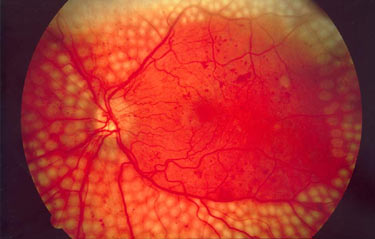Diabetic Retinopathy
posted on Mar 12, 2014 3:19PM

Diabetic eye disease refers to a group of eye problems that people with diabetes may face as a complication of diabetes. All can cause severe vision loss or even blindness. Diabetic eye diseases may include:
-Diabetic retinopathy—damage to the blood vessels in the retina.
-Cataract—clouding of the eye's lens. Cataracts develop at an earlier age in people with diabetes.
-Glaucoma—increase in fluid pressure inside the eye that leads to optic nerve damage and loss of vision. A person with diabetes is nearly twice as likely to get glaucoma as other adults.
Diabetic retinopathy
Diabetic retinopathy is the most common diabetic eye disease and a leading cause of blindness. It is caused by changes in the blood vessels of the retina. In some people with diabetic retinopathy, blood vessels may swell and leak fluid. In other people, abnormal new blood vessels grow on the surface of the retina. The retina is the light-sensitive tissue at the back of the eye. A healthy retina is necessary for good vision.
If you have diabetic retinopathy, at first you may not notice changes to your vision. But over time, diabetic retinopathy can get worse and cause vision loss. Diabetic retinopathy usually affects both eyes.
All people with diabetes--both type 1 and type 2--are at risk. That's why everyone with diabetes should get a comprehensive dilated eye exam at least once a year. The longer someone has diabetes, the more likely he or she will get diabetic retinopathy. If you have diabetic retinopathy, your doctor can recommend treatment to help prevent its progression.
During pregnancy, diabetic retinopathy may be a problem for women with diabetes. To protect vision, every pregnant woman with diabetes should have a comprehensive dilated eye exam as soon as possible. Your doctor may recommend additional exams during your pregnancy.
So remember if you have diabetes get a comprehensive dilated eye exam at least once a year and follow up with your doctor stringently .



.jpg)

.webp)

.webp)
















.webp)




.webp)
.webp)
